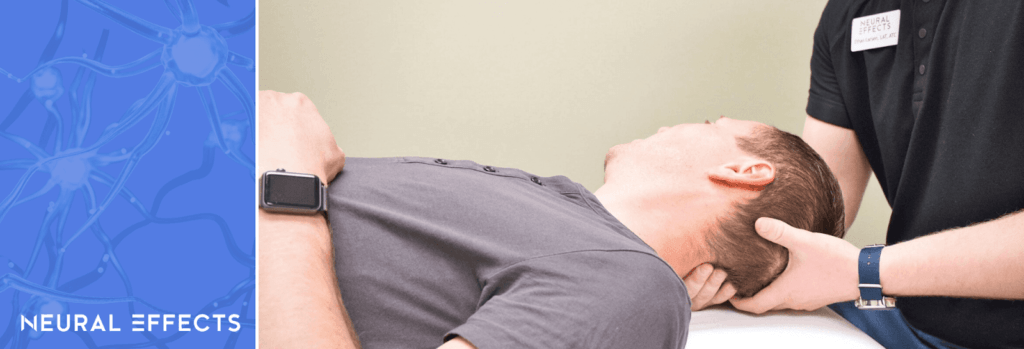A concussion, also known as a mild traumatic brain injury (mTBI), is an injury that temporarily affects how the brain works. Healthcare providers define it as mild because concussions are not usually life threatening. But the effects of a concussion still make it a serious brain injury. It’s important to seek appropriate medical care and follow a plan for the best chances of full recovery.
Research on concussion treatment has progressed significantly in the last few decades. Unfortunately, not all healthcare providers are aware of these changes. They might still recommend “cocooning,” which involves sitting in a dark room and avoiding all forms of cognitive or physical stimulation until symptoms disappear. With cocooning, you’re only allowed to resume your normal activities once all symptoms have cleared.
The idea was to reduce demands on the brain during a vulnerable time, but unfortunately, this is not an option for up to 30% of concussion patients, for whom symptoms may last for months or even years.
This practice has somewhat fallen out of favor with some doctors after scientific studies showed it’s not beneficial for the patient. In fact, it may even lead to mood swings and anxiety in concussed patients. On the other hand, a gradual return to mental and physical activity speeds up recovery times and reduces the risk of long-term symptoms.
Cocooning also makes it more likely that your symptoms will not go away. Think of your brain like a muscle: If you want it to get better quickly, it needs to be exercised!
Following an active recovery schedule that involves therapy and a progressive return to daily activities will help you recover faster and reduce the chance you’ll have long-lasting symptoms.
At our concussion clinic, Neural Effects, we guide our patients through therapy and at-home exercises to gently help the brain recover. The number one regret we hear from our patients is that they didn’t come in for treatment sooner. Many tried cocooning for two or three weeks but eventually realized that their symptoms were not getting better. Once they start therapy, they notice improvement.
No matter how you approach concussion recovery, however, you’ll still have to deal with concussion symptoms — generally for at least two weeks. Even if they are temporary, concussion symptoms such as headaches and dizziness can be frustrating. In addition to explaining what to do for a concussion, we’ll explain what options you have to minimize suffering from the most common concussion symptoms.
Here’s what we cover in this post:
- How to determine if you have a concussion.
- What to do after you’ve been diagnosed.
- What therapy at Neural Effects is like.
- How to minimize concussion symptom severity.
- What to watch out for during your recovery.
If you live in Provo, Salt Lake City, or anywhere else in the Utah valley area, we can help you recover from your concussion and reduce your chance of long-term symptoms. We are in network for most types of medical insurance. Schedule your evaluation today.
Do I Have a Concussion?

A concussion is a type of traumatic brain injury (TBI) caused by a blow or jolt that forces the brain to move rapidly back and forth against the skull. This sudden movement causes the brain to bounce around or twist, triggering inflammation and disrupting normal brain function.
You don’t have to receive a direct blow to the head to get a concussion. If the force of the injury is enough to reach the brain, the site of the initial impact can be anywhere in the body. After a concussion, some people may lose consciousness for a short time.
Contrary to popular belief, you can have a concussion even if you don’t lose consciousness. In fact, fewer than 10% of concussions involve loss of consciousness!
Symptoms usually appear within a few minutes or hours after the incident, but sometimes, they may not be obvious for a few days. Be on the lookout for any new symptoms in the days following a head injury.
Below is a list of common concussion symptoms put together by our sister clinic, Cognitive FX, that can develop after a brain injury:
Immediate Symptoms | Delayed Symptoms |
|
|
If you have at least one symptom from this list, you may have a concussion. The more symptoms you’re experiencing, the more likely it is that you do have a concussion.
What to Do for a Concussion
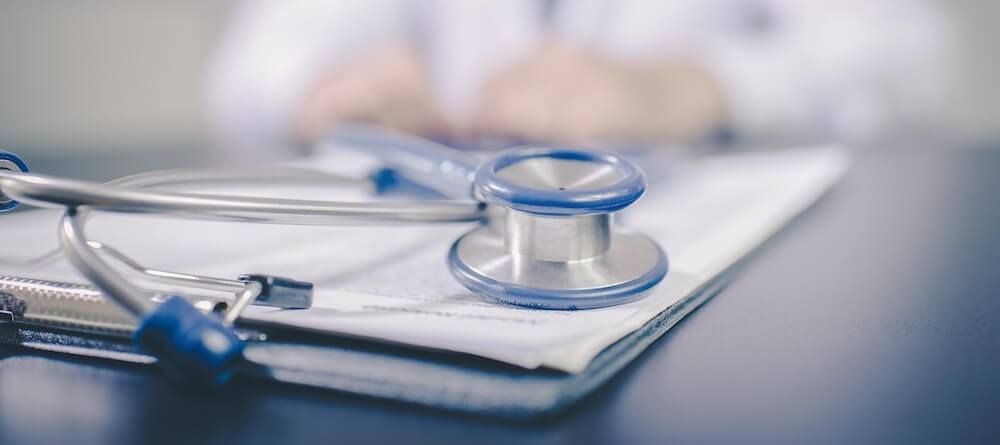
After a brain injury, the first step is to determine if you need emergency care.
Go to the hospital immediately for medical attention if you experience any of the following warning signs of a severe TBI:
- Blood or fluid in the ear.
- Increased drowsiness or lethargic behavior.
- Large bumps, bruises, or swelling on the head.
- Persistent vomiting.
- Seizures.
- Unequal pupil size.
- Worsening headaches, severe headaches, or neck pain.
You may need a CT or MRI scan to look for any fractures in the skull or neck if you have changes to your vision or if you lost consciousness for more than 30 seconds. Your healthcare professional may also want to check if you have any potentially life-threatening symptoms, such as a brain bleed or a blood clot.
Get Assessed as Soon as Possible
If you’ve suffered a mild blow to the head but are not experiencing any severe TBI symptoms, it’s tempting to avoid the emergency room and see how you feel. But a concussion can still be a serious injury, and even if you just feel slightly off, we recommend you seek medical advice.
The best place to be assessed is a concussion clinic like Neural Effects. Our healthcare team knows what to look for when diagnosing a brain injury. They can offer you a more thorough assessment than what doctors who don’t specialize in brain injury diagnosis can provide.
The assessment we use at Neural Effects is as follows:
Post-Concussion Symptom Scale Assessment
The first step involves a detailed assessment of all your symptoms. This is done using a checklist; patients rate each symptom from zero (no symptoms) to six (the worst possible). This reveals important information about what systems have been affected, and it guides the treatment we offer.
For example, if your worst symptoms are related to vision, then we emphasize vision therapy; if you’re struggling with balance, we spend more time rehabilitating the vestibular system.
Medical History Review
Next, we ask detailed questions about your medical history before the concussion. This helps us customize the treatment we offer. For example, some of our therapies involve intense exercise, but we can adjust it if we know the patient has respiratory problems.
In addition, we need to know how your injury happened. Was it a car accident? Or a sports injury? This information will help us during your physical examination.
Medical Imaging
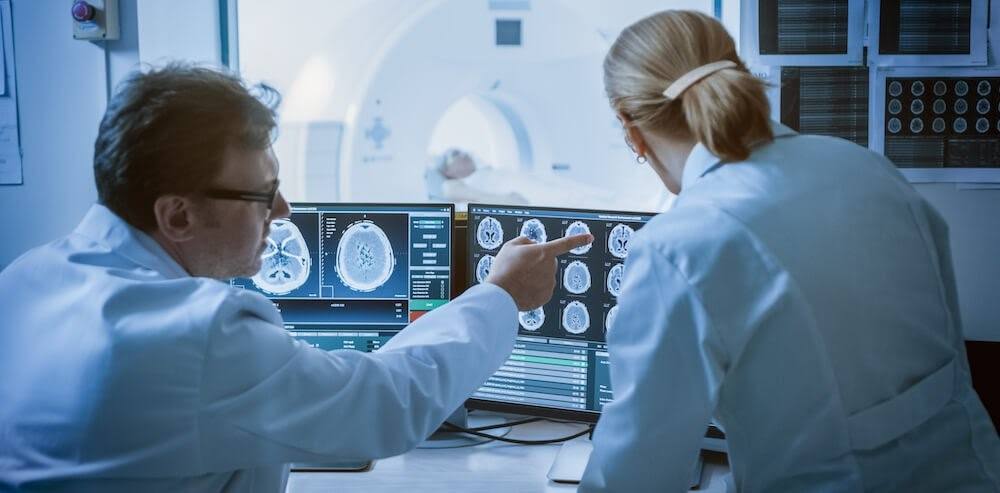
For more severe cases, we may need an X-ray, a CT scan, or an MRI to look for skull/neck fractures or bleeding in the brain. We have access to all equipment we need, and patients get these done promptly if we think it’s necessary.
If you’ve seen another doctor about your brain injury and already have some images of your brain, we’ll review them as long as you send them to us before your appointment.
Sometimes, patients believe they don’t have a concussion because their MRI is normal and didn’t show any signs of injury. This is incorrect. An MRI is great to detect structural changes in the brain, such as what happens after a stroke. However, they’re not actually very helpful to diagnose a concussion. Head injuries are characterized by dysfunctional communication between neurons and the blood vessels that supply them with oxygen and nutrients. This type of brain damage is subtle and microscopic and will not appear on a standard MRI.
Cranial Nerve Exam
This exam assesses twelve sets of nerves that control movement and senses. It includes facial muscles, eye movements, and a series of other indicators that show if these nerves have been affected by your injury. It helps us determine how severe your injury is and whether we need to refer you to a neurosurgeon.
Cervical Spine Exam
This exam consists of palpation of the spine, neck, arms, and hands. Our therapists are looking for anything that could indicate a fracture or a herniated disc. We also measure muscle strength and evaluate whether strength is the same on both sides of the body.
Balance Assessment
Finally, all patients take a Balance Error Scoring System (BESS) test. Patients have to complete a series of simple balance exercises with closed eyes. If you watch sports, this test may be familiar. It’s the same one that sports doctors do with players to check for signs of a concussion.
We also evaluate your vision during this test. Problems with vision are common after a brain injury, including changes to peripheral vision, depth perception, and ability to focus, to name just a few.
The results from all these tests influence the therapy you receive. Most patients are ready to start rehabilitation straight away. Occasionally, we uncover other neurologic problems, such as multiple sclerosis or Parkinson’s Disease. If this happens, we refer patients to a specialist for further treatment.
Physical and Mental Rest for 48 hours
We recommend that you rest for 48 hours after the injury. This means avoiding screen time, loud noises, bright lights, and any other forms of intense sensory stimulation. During this period, if any of your symptoms worsen dramatically or you experience seizures or vomiting, you should go to the hospital immediately.
After 48 hours, you can start a gradual return to normal activities, including work and school. If you play sports — any sport, not just contact sports — you’ll need more than 48 hours before you can return to play.
Treatment at Neural Effects

You can start your treatment with us as soon as two days after you suffer your head trauma. In practical terms, most patients can start immediately after their concussion diagnosis.
Concussions interfere with the connection between nerve cells and the blood vessels that supply them with energy and oxygen. This is called neurovascular coupling. As a result, some areas in the brain don’t receive the amount of blood they need when they need it and fail to complete all their tasks, while other regions try to compensate and do too much. These hyperactive and hypoactive regions are responsible for many of the concussion symptoms you may be having.
It’s possible to encourage healthy neurovascular coupling through a series of exercises that target specific parts of the brain. This is the basis for our treatment, a type of active rehabilitation. It is the total opposite of the “wait-and-see” approach with cocooning and is associated with a greater reduction in symptoms.
A typical treatment consists of three sessions a week for two weeks. This can be adjusted for patients who may need more or fewer sessions.
In addition, our therapists can adapt the work that’s done in each session, including if patients have physical limitations or severe symptoms.
The general structure for each session includes:
- Post-concussion symptom scale.
- Cardio and breathing techniques.
- Vestibular and ocular therapy.
- Neuromuscular and cognitive therapy.
Post-Concussion Symptom Scale
We start and end each session with a post-concussion symptom scale. This is a list of common symptoms, and patients rate them according to how they’re feeling. This allows us to track your progress and adjust treatment.
Cardio and Breathing Techniques
Physical activity releases a cascade of neurochemicals, which are crucial to help your brain heal. For some patients, however, unsupervised exercise can worsen the symptoms to the point they become unbearable.
Part of our treatment involves cardio exercises, such as short bursts on a stationary bike or a treadmill. The trick is to raise your heart rate enough to get the blood flowing in the affected areas in the brain but not enough to increase the severity of your symptoms. This is called exercising at the sub-symptom threshold.
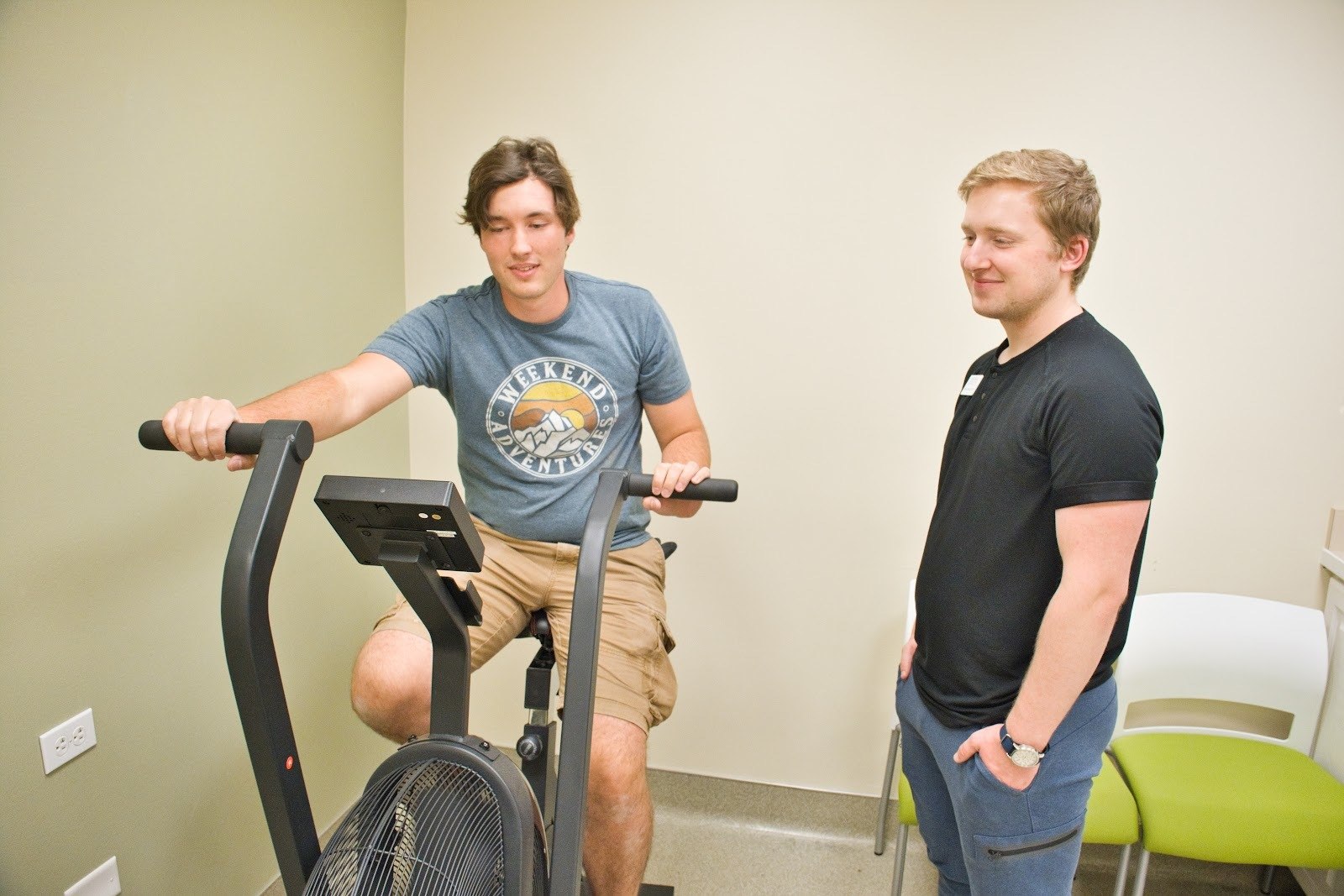
This is why our therapists constantly monitor your symptoms. You can read more here about how cardio intervals help patients recover.
A crucial part of this process is also to show you how to breathe, allowing you to recover from exercise properly. We spend some time teaching you a few techniques you can use at home and during therapy.
Vestibular and Ocular Therapy
Vestibular and ocular therapy is used when patients have symptoms related to vision (ocular) and/or balance (vestibular). This includes, for example, blurry vision, light sensitivity, dizziness, and vertigo. All these symptoms are common after a brain injury.
The aim is to get the eyes and vestibular system working together again.
For example, take our gaze stabilization exercise: Patients focus their eyes on a poster with a large letter ‘A’ that has lines running from it in all directions, then they move their head back and forth along the lines under the direction of a therapist. Another typical exercise involves a string of beads spaced at equal distances (a “Brock string”) to help retrain the eyes to focus properly.
Cognitive and Neuromuscular Therapy
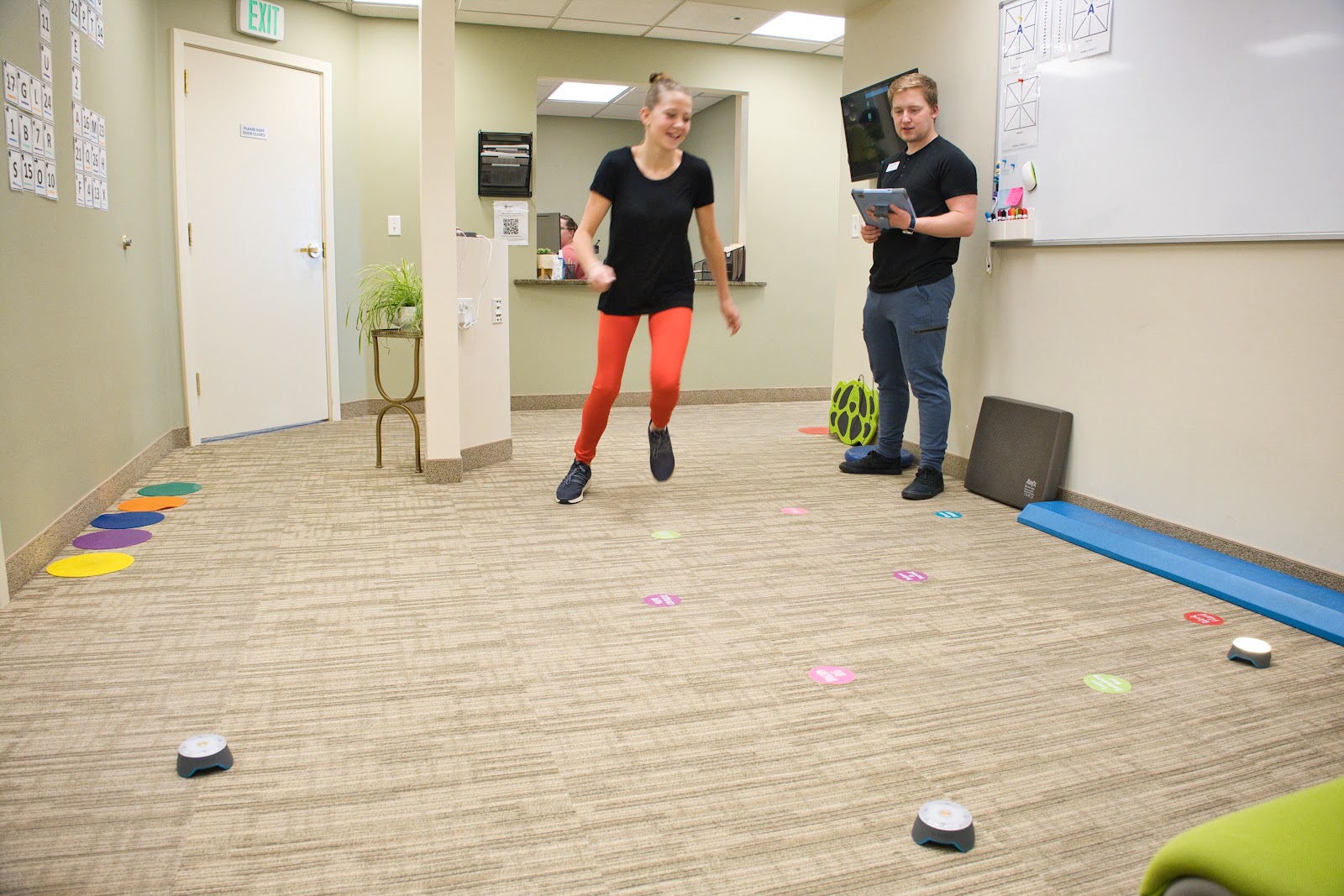
Neuromuscular therapy works the brain and the body at the same time. The aim is to jumpstart the areas affected by the concussion so they can go back to their pre-injury status. Examples of exercises our therapists use include balancing on a Bosu ball while playing a memory game or hitting targets that light up in random patterns to improve reaction time. Patients also have to solve some cognitive games, such as memorizing pictures, solving a logic puzzle, and finding patterns.
After the Treatment
Throughout your appointments, our therapists not only monitor your symptoms closely, but they also give you the skills to continue your rehabilitation at home.
This involves using the post-concussion symptom scale (mentioned above) as a guide.
If you try a new activity, and your symptom severity values remain within three points before and after, then you should be safe. On the other hand, if there’s more than three points, you are not ready yet.
At the end of the sessions, you will be given homework. This consists of about an hour of aerobic exercise, some cognitive games, and controlled breathing and relaxation techniques. Completing these exercises gives you a better chance of a fast and complete recovery.
If you have a sport-related concussion, we’ll help you with paperwork and coordinate with your coach or athletic trainer on when you can return safely to play.
How to Deal with Concussion Symptoms During Your Recovery

Most patients we see at Neural Effects make a full recovery within two weeks to a month after the injury. Common symptoms of a concussion during this period include headaches, mood swings, sensitivity to light and noise, poor sleep, and nausea.
A good way to keep these symptoms under control during this period is to exercise. This not only relieves stress and tension but also provides a boost that promotes healing. If you’re not sure what to do, this post on post-concussion exercise can help you.
It’s also important to eat a balanced diet and take vitamin supplements, if needed. For many brain injury patients, mindful breathing exercises are an essential way to regulate their mental health, mood changes, and memory. You can read more about mood and personality changes after a concussion here.
Avoid stimulants or depressants such as coffee and alcohol. You may experience some temporary relief from severe headaches, but they are likely to make your symptoms worse in the long term. Headaches can be caused by many factors.
For example, if you have a headache caused by persistent sinus inflammation, placing a hot pad on the sinuses may help. For spine-related headaches, try stretching the neck to alleviate muscle tension. Tylenol (acetaminophen) is a safe over-the-counter pain medicine to take the edge off; avoid NSAIDs like Advil and Motrin (ibuprofen), Aleve (naproxen), or aspirin since they could increase your risk of brain bleeds after an injury. A good place to find other tips on how to get rid of concussion headaches is this post from Cognitive FX.
If you’re struggling with light sensitivity, use sunglasses outside. We don’t recommend that you use them inside because it will reinforce the problem. For severe cases, colored lenses may be an option, but you will need to stop using them eventually. Limit the time you spend in front of a phone or computer screen playing video games, as it can overwhelm an already taxed brain. If you do have to spend a considerable amount of time in front of a screen for work, get glasses to filter out blue light to reduce the risk of headaches. Learn more about what causes light sensitivity and what you can do about it.
Many concussion patients complain of poor sleep. If you find yourself tossing and turning in bed, one of the best things you can do is have a consistent and calming bedtime routine. Pick a bed time and always stick to it. Just before bed do something to calm down, such as listen to music or meditate. We advise against sleeping pills, unless you can only sleep for an hour or two every night. Find out why you’re suffering and what you can do about it.
Another common symptom after a concussion is nausea. If certain smells trigger your nausea, find something strong and soothing to smell, such as peppermint oil. If it’s exercise that makes you nauseated, find a therapist to teach you controlled hyperventilation and deep breathing techniques. Don’t be tempted by herbal remedies, as these could make your symptoms worse. Read more about nausea, why do you feel sick, and what to do about it.
If you have high sensitivity to noise, you can use noise-cancelling headphones. If it’s tolerable, however, don’t completely avoid loud noises. While it may seem like an easy option for treatment, it’s actually counterproductive. Total avoidance of sounds can actually increase sensitivity. Have a designated silent area at home or find a quiet park where you can find silence when you need it.
Possible Complications from a Concussion
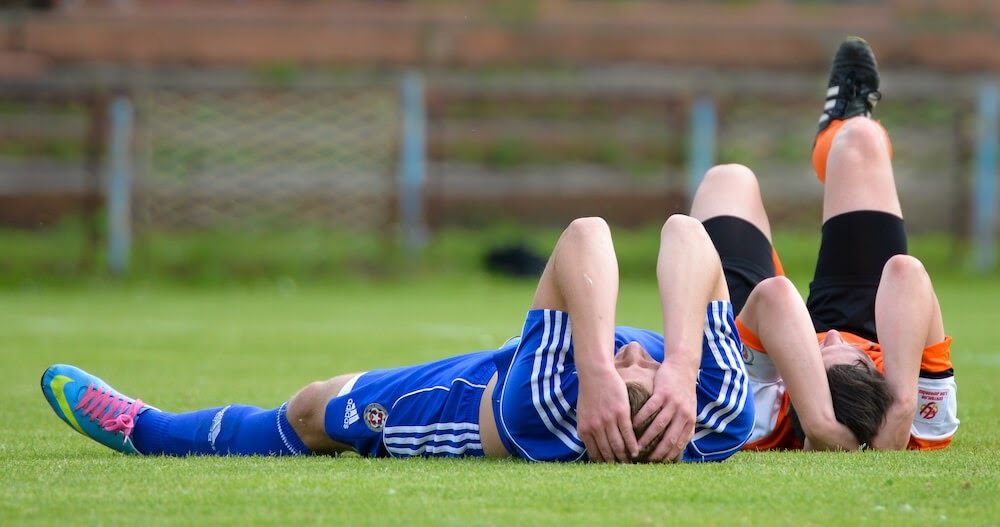
As mentioned earlier, for most patients, symptoms go away after a few weeks. But for up to 30% of patients, symptoms last longer and develop into post-concussion syndrome. Over time, patients tend to experience a wide range of symptoms, and it can be an extremely debilitating condition for some. If you want to find out more, you can read the full guide to post-concussion from our sister clinic, Cognitive FX.
Another complication from brain injuries occurs when a second concussion happens before the first one has completely healed. This is called second impact syndrome and can lead to severe brain bleeding, which can be fatal.
Athletes are a high-risk group because concussions can go undetected or concussed players want to return to the field before they are ready. It’s vital that both athletes and coaches understand the signs of concussion to ensure athletes get adequate time for their brain injuries to heal.
Over the past few decades, research has also unveiled a link between brain trauma and an increased risk of degenerative diseases such as Alzheimer’s and dementia later in life. For example, a study found that the risk of dementia increased by four to six times after a traumatic brain injury. That said, researchers are still not entirely sure whether head injuries are a direct cause of dementia or whether there are other mechanisms at play.
At Neural Effects, we pride ourselves in using the best therapies from different fields and putting them together into a multidisciplinary approach to concussion care.
If you or a loved one have suffered a concussion recently, why not schedule your evaluation with us? The sooner you address your symptoms, the sooner you can start to recover. Treatment at Neural Effects is in network with most insurance providers, including Regence BlueCross BlueShield, Aetna, SelectHealth, Medicare, and many more.
